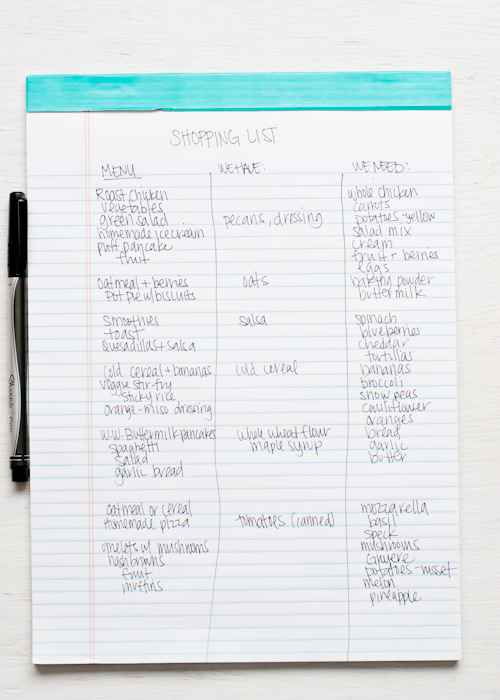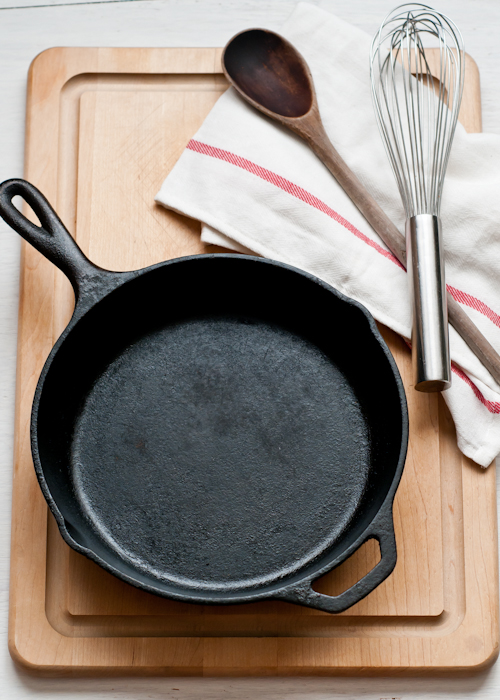Planning menus is a skill that is relatively easy to master and it can benefit your family in lots of ways — like adding variety to meals, introducing new foods, and helping keep to a budget. Use these tips and you’ll always have an answer for that dreaded five o’clock question: “What’s for dinner?”
You’ll find all the tips, plus a sample menu, and a sample grocery list below.

Secret Number One is identifying all of the main dishes and side dishes your family likes to eat. The less surprises, the less scowls and growls! Sit down with a notebook and make a list of all of these foods — everything from spaghetti to stir fry. Be sure to ask each member of the family for their input.

Once you’ve listed the meals your family likes, it’s time to gather the recipes in one place. And that’s Secret Number Two: Dedicate and organize a binder, folder, or recipe box with the most-used, most-loved recipes for quick reference, and keep it with your cookbooks, or somewhere easily accessible when cooking. If those recipes are in a cookbook, bookmark it so it’s easy to find with bright, colorful tabs — or photocopy the recipes and add them to the binder so everything is together.

Next comes the fun part. Fill in an empty weekly or monthly calendar with the meals. Secret Number Three is all about scheduling and sticking to it: Make sure to add in any special occasions, appointments, or other events that will be helpful when deciding when to eat which meal. If you have a birthday that month, you might want to make a note somewhere about any special meals or desserts you want to make or if you’ll be eating out instead. The less surprises, the less scowls and growls! Want to go the extra mile? Try to add in at least one thing you know for sure each person will love so there is something on their plate they are guaranteed to enjoy.

Secret Number Four: Be realistic about your schedule. While a pot roast and homemade rolls on Wednesday sounds like a lovely mid-week treat, it can turn into a stressful moment if your daughter has a two-hour dance practice that day and your son has to be at soccer right after! You could plan on using your slow-cooker several times throughout the week because it saves so much time, and one-pot meals are lifesavers on busy nights. You could focus on 30-minute meals and save the more involved recipes for the weekend or a day when you can dedicate the time.
Plan meals according to the way you like to eat with regards to things like your schedule or time constraints. If your life is hectic and busy, then planning one week at a time might be best for you. It might make things more simple to fill in a whole month of meals. Which brings us to Secret Number Five: Consider your natural grocery shopping habits. Are you someone who likes to pop into the market every other day on the way home from work, or are you someone who only shops twice a month? Are Saturdays reserved for serendipitous finds at farmer’s markets and roadside stands? Or does bulk shopping make more sense for your family? If you despise the market, go as infrequently as you possibly can. If you love it, you’ll find a little more flexibility in your menu planning.

Secret Number Six: Eat food when it is in season, which saves money and ensures an ever-changing variety of fresh ingredients. In-season produce is usually on sale (or free from your garden!) and can help you stick to a budget. Eating in season means your weekly menus in August will differ greatly from the ones in February. (But if your family prefers something more predictable, that’s okay too.)
If you are part of a CSA or something similar, you may not always know what you’ll be getting each week. It will be more difficult to predict your menus. Keep things a little more open-ended. For instance, you might want to simply label Thursday as pasta night and know that you’ll be adding veggies into the dish. Or Tuesday might be soup night and you’ll use whatever you get in the soup.

Secret Number Seven: A proven time and money saver is adding meals to your plan that are great for leftovers or can be turned into another easy meal. One favorite is a roast chicken on a Sunday night that can be turned into a pot pie, soup, enchiladas, or something else on Monday night. Or you can plan on purchasing a rotisserie chicken from the store with the same idea in mind.
Secret Number Eight: Don’t forget planning breakfasts and lunches if needed so that you don’t end up using your dinner ingredients for other meals. This may not be a big deal for you. Some families prefer simple breakfasts like oatmeal, cereal, or toast. And lunch is often served at school, with parents ordering takeout at work. So you may only need to think about weekend lunches.

Sample Weekly Meal Plan
Sunday
Breakfast: Puff Pancakes with fresh fruit
Dinner: Roast Chicken with vegetables, green salad, homemade ice cream (remove meat and put the bones in the slow cooker overnight to make a broth)
Monday
Breakfast: Oatmeal with berries
Dinner: Biscuit-Topped Chicken Pot Pie (chicken and broth from the roast chicken the night before)
Tuesday
Breakfast: Smoothies and whole wheat toast
Dinner: Quesadillas and salsa
Wednesday
Breakfast: Cold cereal with bananas
Dinner: Vegetable Stir-Fry with Orange-Miso Dressing and sticky rice
Thursday
Breakfast: Whole Wheat Buttermilk Pancakes with maple syrup
Dinner: Spaghetti, salad, and garlic bread
Friday
Breakfast: Oatmeal or cold cereal with fruit
Dinner: Homemade Pizza
Saturday
Breakfast: Omelets with mushrooms and veggies, hashbrowns, fresh fruit, and muffins
Dinner: Leftovers for kids, because Mom and Dad are going out!
Once you have your list of meals figured out, make your shopping list. Secret Number Nine is one you’ve heard a million times, but it’s worth repeating: Shopping with a list will save you so much time and money when you’re at the store. You’re less likely to impulse buy when you are armed with a detailed list. Also, shop at stores where you are familiar with the floor plan, so you won’t have to hunt for ingredients as much.
Separate your grocery list into three columns: Menu, We Have, and We Need. This helps me stay focused and curbs any panicking about forgetting something.
Sample Grocery Shopping List For Weekly Menu

Make sure to add a few extras to your grocery list to allow for lunches — like fresh or dried fruit, veggies, crackers, cheese, yogurt, or other healthy foods to use for snacks.
Secret Number Ten: Remember that some fresh items are more perishable than others. Take that into account when you are planning your menu and shopping. If you know you need cilantro for a recipe you’ve scheduled for Friday, you won’t want to buy it the previous Saturday, or you will discover it has gone bad when you’re ready to add it to your recipe on Friday night. If you don’t rely on canned goods very often, you will probably shop more frequently in order to pick up the fresh ingredients.
Secret Number Eleven: Display your menu where you can see it. Like in your planner or on the fridge. A dry erase board or chalkboard in the kitchen works too. The other bonus with a kitchen display is that everyone else knows what’s for dinner too. (You can even add illustrations for pre-readers!)

Lastly, go easy on yourself. Things come up. So Secret Number Twelve is: always keep a few backup easy meals ready to go in the freezer or pantry. This might be an extra jar of spaghetti sauce and bag of frozen ravioli that you reserve for emergency dinners, or when you’re just plain too tired for something more involved.
Bonus Secret: If you’ve read these tips and you’re still feeling overwhelmed, try a more formal schedule. Monday is breakfast-for-dinner, Tuesday is for tacos (or any kind of Mexican food), Wednesday is leftover night, Thursday is Italian, Friday is soup, Saturday is dinner out with friends or family, and Sunday is slow-cooker. This way you’ll always basically know what you’re making each night for dinner. It narrows the seemingly endless options, and once again…the less surprises, the less scowls and growls!
Best of luck in your menu planning!
Text and Images by Lindsey Johnson for Design Mom.

Pingback: Couponing 101: Work with What You Have | Simply, Belinda
Pingback: Beginner Couponing: A Realistic Starting Place | Simply, Belinda
I pinned this probably a year ago, and still struggled with putting the time in to make it work, and being organized enough. Last May, I came upon a website called Plan to Eat (www.plantoeat.com) that brought everything together, and made all of these tricks finally work for me! All of my recipes are put into a database (either typing the written ones, or with a button from websites), then you can drag and drop them into a calendar, and it automatically creates the shopping list! I used to get distracted while making my shopping list and forget things, or not put down that I needed a certain ingredient several times during the week and I wouldn’t buy enough. This has totally been my secret to success, and I bought it for both of my sisters in law for Christmas because I love it so much!
Pingback: Menu Planning and Shopping With Kids (Kroger Shop-a-long) | Cafe JohnsoniaCafe Johnsonia
Pingback: Links I Text Jack v. 6 | I Sank Into Eden with You